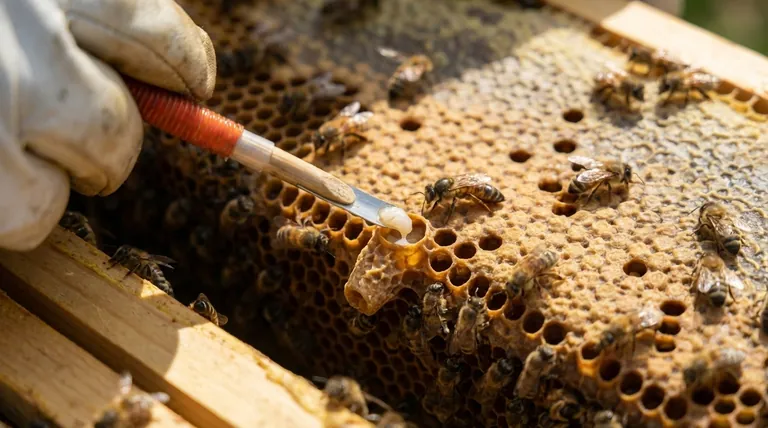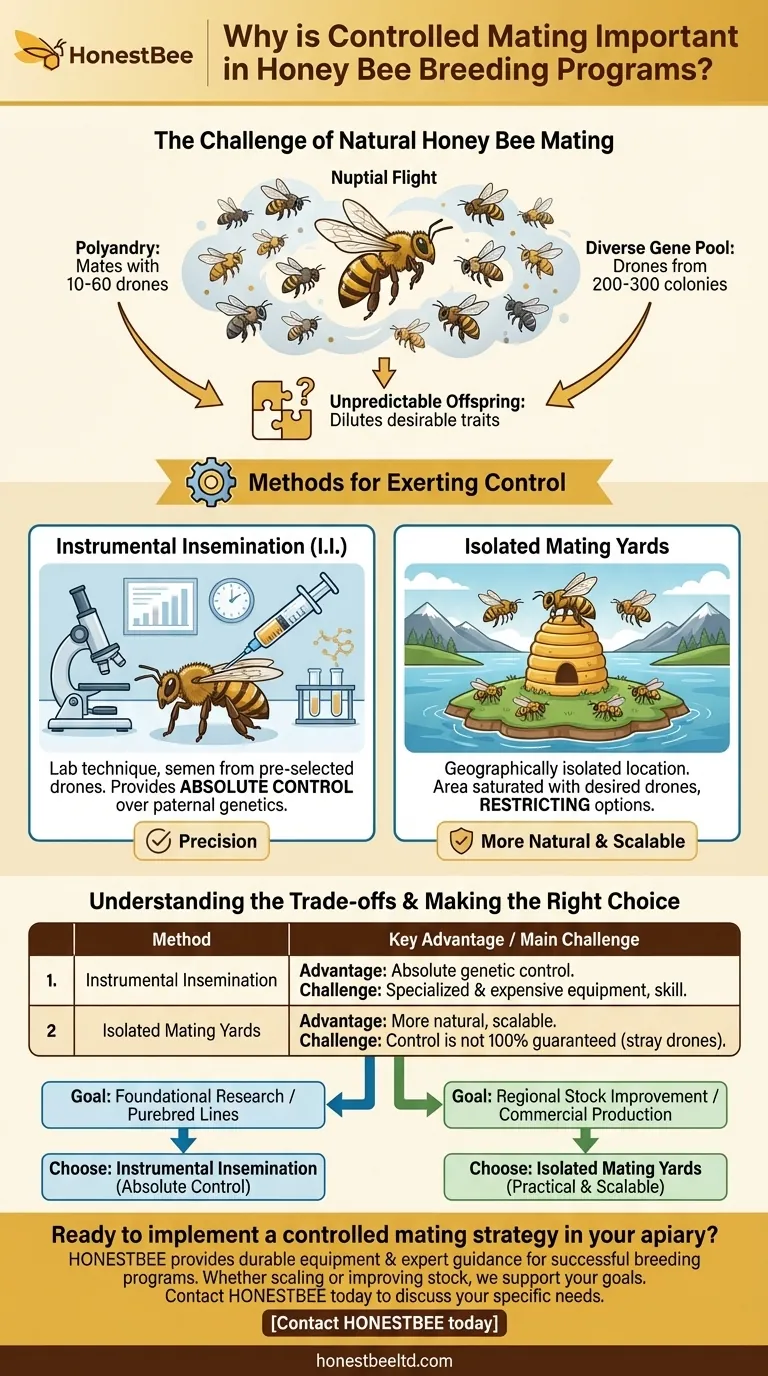In short, controlled mating is critical because queen honey bees naturally mate with a large, random assortment of drones in mid-air. This open mating behavior makes it nearly impossible to selectively breed for desirable traits like disease resistance or high honey production without direct intervention.
The fundamental challenge in honey bee genetics is the queen's uncontrolled nuptial flight with dozens of drones from unknown colonies. Controlled mating transforms bee breeding from a game of chance into a predictable science, allowing for the targeted genetic improvement of entire populations.

The Challenge of Natural Honey Bee Mating
To understand why control is so important, you must first understand the natural process that breeders are working against.
The Queen's Nuptial Flight
A young virgin queen leaves the hive on a "nuptial flight" to mate. This occurs high in the air in areas known as drone congregation areas.
The Problem of Polyandry
Honey bees are polyandrous, meaning the queen mates with multiple partners. She will mate with anywhere from 10 to 60 different drones during one or more nuptial flights.
A Vastly Diverse Gene Pool
These drones come from a wide geographic area, potentially representing 200 to 300 different colonies. The queen stores the semen from all these drones and uses it to fertilize eggs for the rest of her life.
Why This Undermines Breeding Goals
This process creates immense genetic diversity, which is beneficial for wild colony survival. However, for a breeder, it's a significant problem. If you have a queen with excellent genetic traits, her mating with dozens of random drones completely dilutes that desirable lineage, making the traits of her offspring unpredictable.
Methods for Exerting Control
Breeders use specific techniques to overcome the randomness of natural mating and ensure desired genetic crosses.
Instrumental Insemination (I.I.)
This is a laboratory technique where a queen is anaesthetized and inseminated with semen collected from specific, pre-selected drones. It provides absolute control over the paternal genetics.
Isolated Mating Yards
This method involves placing queen mating hives in a geographically isolated location, such as an island or a remote valley. The area is then saturated with drones from only the desired, high-quality colonies, restricting the queen's mating options to the preferred stock.
Understanding the Trade-offs
Each method of control comes with its own set of advantages and disadvantages that breeders must weigh.
The Precision of Instrumental Insemination
Instrumental insemination offers unparalleled precision, guaranteeing the paternal lineage. However, it requires specialized and expensive equipment, a high degree of technical skill, and significant training to perform correctly.
The Practicality of Isolated Mating
Isolated mating is a more natural process and can be scaled more easily for larger operations. The primary drawback is that control is never 100% guaranteed. Finding true geographic isolation is difficult, and stray drones can sometimes enter the area, compromising the genetic purity of the crosses.
Making the Right Choice for Your Program
Your choice of method depends entirely on the specific goals and available resources of your breeding operation.
- If your primary focus is foundational research or developing purebred lines: Instrumental insemination offers the non-negotiable, absolute genetic control required for this work.
- If your primary focus is regional stock improvement or commercial queen production: Isolated mating yards often provide a more practical and scalable balance between genetic control and operational efficiency.
Ultimately, mastering controlled mating is the key that unlocks the potential to systematically improve the health, behavior, and productivity of honey bee populations.
Summary Table:
| Method | Key Advantage | Main Challenge |
|---|---|---|
| Instrumental Insemination | Absolute genetic control | Requires specialized equipment & skill |
| Isolated Mating Yards | More natural & scalable process | Control is not 100% guaranteed |
Ready to implement a controlled mating strategy in your apiary?
As a leading wholesale supplier to commercial apiaries and distributors, HONESTBEE provides the durable equipment and expert guidance needed for successful breeding programs. Whether you're scaling queen production or improving regional stock, we have the solutions to support your genetic improvement goals.
Contact HONESTBEE today to discuss your specific needs and explore our range of beekeeping supplies.
Visual Guide

Related Products
- Retractable Chinese Queen Rearing Grafting Tools Equipment
- Plastic Chinese Queen Grafting Tool for Bee Queen Rearing
- Wooden Queen Bee Excluder for Beekeeping
- Professional Plastic Queen Excluder for Modern Beekeeping
- High Performance Plastic Queen Excluder for Beekeeping and Apiary Management
People Also Ask
- How should the frame of larvae be prepared for grafting? A Guide to Maximizing Larval Survival
- What is the Doolittle method of queen rearing? Master Controlled Queen Production for Your Apiary
- Why might grafting be a disincentive for beginners in beekeeping? Explore Simpler Queen Rearing Methods
- What is the process of grafting larvae? Master the Art of Queen Rearing for Your Apiary
- What are the key steps in the grafting technique? Master Queen Rearing for a Thriving Apiary



















